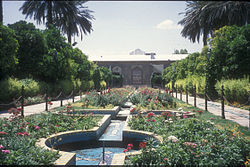카슈미르힌두스
Kashmiri Hindus 잠무와 카슈미르에 있는 하리 파르바트 사원. | |
| 언어들 | |
|---|---|
| 성어 산스크리트어 민족어 힌디어, 우르두어, 영어 | |
| 종교 | |
| 다수 카슈미르 샤이즘 소수자 샤이즘, 비슈나비즘, 샤크티즘 | |
| 관련 민족 | |
| 카슈미르인, 카슈미르인 무슬림 |
| 시리즈의 일부(on) |
| 인도의 힌두교 |
|---|
카슈미르 힌두교도는 힌두교를 믿는 카슈미르 민족으로 인도의 카슈미르 계곡이 원산지입니다.[1]인도 철학에 대한 그들의 기여와 관련하여 카슈미르 힌두교도들은 카슈미르 시아파의 전통을 발전시켰습니다.[2]1990년대 카슈미르 반란을 계기로 카슈미르 계곡을 탈출한 카슈미르 힌두교도 대부분은 현재 잠무와 카슈미르의 잠무 사단과 다른 지역에 정착해 있습니다.카슈미르 힌두교도들의 가장 큰 집단은 카슈미르 판디트들입니다.
역사
고대의
힌두교는 카슈미르 사람들에 의해 행해진 가장 오래된 기록된 종교입니다.[2][3]기원전 3세기 불교가 들어오기 전에는 샤이브파 힌두교가 카슈미르 계곡의 지배적인 종교였고, 카슈미르는 북인도의 브라만 통치의 상징이었습니다.[4][3][2]
아쇼카 (기원전 304–232)의 통치 기간 동안, 카슈미르는 마우리아 제국의 일부가 되었고 불교가 카슈미르에 도입되었습니다.이 시기에 힌두교는 주요 종교로서 쇠퇴하기 시작했고,[5][4] 많은 부도, 시바에게 바치는 몇몇 성지, 그리고 스리나가리(스리나가르)라는 도시가 세워졌습니다.쿠샨 제국의 황제였던 카니슈카 (127–151 CE)는 카슈미르를 정복하고 카니슈카푸르라는 새로운 도시를 세웠습니다.[6]
중세의
카르코타 왕조는 카슈미르와 북부 인도 아대륙의 일부 지역을 통치했으며, 그들의 통치는 정치적 팽창, 경제적 번영, 카슈미르의 출현을 문화와 학문의 중심지로 보았습니다.[7][8]랄리타디티야 묵타피다 (724–760 CE)는 인도 아대륙 카슈미르 지역의 카르코타 왕조의 강력한 통치자였습니다.7세기 이후 카슈미르 힌두교에서 중요한 발전이 이루어졌습니다.그 후 몇 세기 동안, 카슈미르는 산스크리트 문학과 힌두 종교에 기여한 많은 시인, 철학자, 예술가들을 배출했습니다.이 시기의 주목할 만한 학자들 중에는 카슈미르 샤이비즘이라고 불리는 일원론적인 시바 체계의 기초를 닦은 시바 경전을 쓴 바수굽타 c.(875–925 CE)가 있었습니다.[9]
로하라 왕조의 여명기 이후 이슬람교는 카슈미르 밖의 나라들로 침투하였고, 다수를 차지하고 있던 힌두교도들의 지지가 없는 상황에서 린차나는 카슈미르 무슬림들의 지지가 필요했습니다.린차나의 후계자에 대한 샤 미르의 쿠데타는 무슬림의 통치와 카슈미르에서 그의 왕조의 통치를 확보했습니다.[10]
인구통계학
카슈미르 힌두교도 내의 가장 큰 공동체는 카슈미르 판디트(카슈미르 브라만)인데,[11][12] 그들은 사제(고르 또는 바샤 바타), 점성가(주트시), 그리고 노동자(카쿤)와 [13]같은 여러 고트라들로 나뉩니다.[14]
와니족은 케사르와니족과 같은 하위 카스트를 가진 역사적으로 바니아족입니다.[15]무굴 시대 동안, 많은 케사르와니인들은 마디야 프라데시, 비하르, 우타르 프라데시와 같은 인도의 다른 지역으로 이주했습니다.[16]
관계자에 따르면 2021년 6월 말까지 잠무와 카슈미르의 주소 증명서를 발급받은 카슈미르 힌두교도는 98,600명이라고 합니다.그들은 또한 "실향민 카슈미르 판디트에게 90,430개의 거주 증명서가 발급되었고, 실향민 카슈미르 판디트의 2,340개 가족이 새로운 이주자로 등록되었습니다.이 중 8,170명이 본적증명서를 받았습니다."[17]
2020년 5월 16일, 잠무 및 카슈미르 재난 관리, 구호, 재활 및 재건 부서(JK DMRR)에 의해 명령 52가 발표되었습니다. "아직 구호 및 재활 위원(이주민), 잠무 및 카슈미르에 등록되지 않은 보나파이드 이주민과 보나파이드 실향민, 관할 기관에 주소 증명서 발급만을 목적으로 등록을 신청할 수 있습니다."이것은 필요한 서류 중 하나만 제공하면 됩니다.카슈미르 이주민과 실향민의 등록 기간은 이후 2022년 5월 15일까지 연장되었습니다.[18]
박해
서기 14세기 술탄 시칸데르 부트시칸의 통치 아래, 많은 카슈미르 힌두교도들이 이슬람교로 강제 개종했습니다.[19][20]그들은 1990년대에 밸리의 대규모 군사화 이후 군사적 폭발이 일어나면서 훨씬 더 많은 수의 밸리를 떠나기 시작했습니다.
주목할 만한 사람들
이것은 주목할만한 카슈미르 힌두교도들의 목록입니다.
- 인도 배우 아누팜 케르
- 바이 알마스트, 우다시 성인
- 바이 발루 하스나, 우다시 성인
- 인도 배우 쿠날 케무
- R&AW 설립자 중 한 명이자 제1비서 RN Kao
- Krsna (래퍼), 인도 래퍼
- 인도 초대 총리 자와할랄 네루
- 인도 배우 모히트 레이나
- 스탠드업 코미디언이자 체스 애호가인 Samay Raina
- 인도 배우 바샤 숨블리
- 변호사 티카 랄 타플루
- 변호사이자 인도국민회의[21] 의장인 모틸랄 네루.
- 인디라 간디 전 인도[21] 총리
- P. N. 학사르, 관료 겸 외교관[22]
- 테즈 바하두르 삽루, 자유 투사, 변호사, 정치인[23]
- 타피쉬와르 나레인 레이나, 인도군[24] 제9군 참모총장
- 구자라트카드레의[25] 인도 경찰관 산지브 바트.
- 람 찬드라 칵, 잠무 카슈미르 총리 (1945-1947)
- 여행가, 외교관, 작가, 그리고 위대한 게임의 중요한 선수인 Mohan Lal Zutshi.[26]
참고 항목
서지학
- 호레이스 헤이먼 윌슨의 힌두 카슈미르사 ISBN9788186714300, 8186714308
- 카슈미르 힌두 종교 문화 바이 차만 랄 가두 ISBN 9788191005714, 8191005719
- 카슈미르의 힌두교도들 - 반시 판디트 ISBN 9798586697035에 의해 잊혀진 대량학살
- 존 시우드막 ISBN 9789004248328, 9004248323에 의한 고대 카슈미르의 힌두불교조형물
- 카슈미르: Tej K Tikoo 대령에 의한 원주민과 그들의 출애굽기 ISBN 9781935501589, 1935501585 ISBN 9781942426417, 1942426410
- Kassheer - 사하나 비자야쿠마르 ISBN 9781942426417에 의한 카슈미르 힌두교도의 악마적 배신
- 수루치 프라카샨에 의한 카슈미르의[27] 힌두교도 집단 학살
- Rajat Kanti Mitra ISBN 9781088402733, 1088402739 옆방의 이교도
- M. L. 바트 박사의 카슈미르의 오디세이 목적지-고향-파눈 카슈미르 ISBN 9781947586253, 1947586254
참고문헌
- ^ Ling, Huping (2008). Emerging Voices: Experiences of Underrepresented Asian Americans. Rutgers University Press. p. 126. ISBN 9780813543420.
Kashmiri Muslims represent the majority population in Kashmir Valley, while Kashmiri Hindus represent a small but significant minority community.
- ^ a b c Snedden, Christopher (2015). Understanding Kashmir and Kashmiris. Hurst Publishers. p. 27, 39. ISBN 9781849043427. Retrieved 30 September 2023.
Before Buddhism, Kashmiris engaged in a range of Aryan-inspired religious practices which arose from Sanatana Dharma (the eternal law or way) and which practices now might be labelled 'Vedic' or 'Hindu'. Post-Buddhism, Kashmir was the home of Kashmiri Shaivism (or Trika- Shasana, Trika-Shastra, Trika), a set of monistic beliefs based on merging oneself in Shiva (or universal consciousness), the god of choice of many Kashmiri Hindus.
- ^ a b Bamzai, P.N.K. (1994). Culture and Political History of Kashmir, Volume 2. M.D. Publications Pvt. Ltd. p. 200. ISBN 9788185880310. Retrieved 3 October 2023.
…Saivism must have been the predominant religion in Kashmir long before Buddhism was introduced there.
{{cite book}}: CS1 유지 : url-status (링크) - ^ a b "The Early History of Islam in Kashmir". Egypt Today. 24 June 2017. Archived from the original on 17 November 2018. Retrieved 30 September 2023.
About 300 BCE, Buddhism arrived in Kashmir from further south in India and started to flourish in the region. Before this, Hinduism (of some form) had been the predominant religion in Kashmir for centuries. .... It did not not take long for Kashmir, then, to become a symbolic White House of Brahminical rule in northern India.
- ^ Ahmad, Khalid Bashir (23 June 2017). Kashmir: Exposing the Myth Behind the Narrative. SAGE Publications. p. 11. ISBN 9789386062819. Retrieved 30 September 2023.
When Hinduism was declining as the faith of people in Kashmir, the teachings of Gautama the Buddha received universal acceptance across the length and breadth of the country. Kashmir became one of the most important centres for the spread and development of the new faith. It is generally believed that Buddhism became dominant in Kashmir during the reign of Emperor Ashoka (3rd century BC).
- ^ Chatterjee, Suhas (1998). Indian Civilization and Culture. M.D. Publications Pvt. Ltd. ISBN 978-81-7533-083-2.
- ^ Larson, Gerald James (2007). "Nagas, Monks, Tantrics and Poets". In Pal, Pratapaditya; Ames, Frank (eds.). The arts of Kashmir. Asia Society ; 5 Continents. pp. 36–37.
- ^ Witzel, Michael (2016). "Kashmiri Brahmins under the Karkota, Utpala and Lohara Dynasties, 625-1101 CE". In Franco, Eli; Ratié, Isabelle (eds.). Around Abhinavagupta: Aspects of the Intellectual History of Kashmir from the Ninth to the Eleventh Century. Leipziger Studien zu Kultur und Geschichte Süd- und Zentralasiens. Münster, Germany. pp. 609–643. ISBN 978-3-643-90697-7.
{{cite book}}: CS1 유지 관리: 위치 누락 게시자(링크) - ^ Art, Los Angeles County Museum of; Pal, Pratapaditya (1 January 1986). Indian Sculpture: Circa 500 B.C.-A.D. 700. University of California Press. pp. 51. ISBN 978-0-520-06477-5.
- ^ Unesco (1 January 1998). History of Civilizations of Central Asia. UNESCO. pp. 306. ISBN 978-92-3-103467-1.
- ^ Mufti, Gulzar (24 September 2013). Kashmir in Sickness and in Health. Partridge Publishing. p. 121. ISBN 9781482809985.
Hindus of the Kashmir Valley, known as Pandits, are mostly upper caste Brahmins.
- ^ Kachru, Onkar (1998). Jammu, Kashmir, Ladakh. Atlantic Publishers. p. 75. ISBN 9788185495514.
Taking into account decennial growth rates and migration patterns, the 1981 census data suggests that there would have been 161,000 Hindus, most of them Kashmiri Pandits, in the valley in 1991.
- ^ South Asian Language Review, Volumes 3-4. Creative Publishers. 1993. p. 64.
'Kashmiri Brahmins are said to have originally belonged to only six gotras, -By intermarriage with other Brahmins the number of gotras multiplied to 199' ( Koul 1924).
- ^ Nagano, Yasuhiko; Ikari, Yasuke (1993). From Vedic Altar to Village Shrine: Towards an Interface Between Indology and Anthropology. National Museum of Ethnology. p. 186. Retrieved 29 September 2017.
The Hindus belong with few exceptions to the Brahman caste and are known as 'Pandits', while in other parts of India they are generally called 'Kashmiri Pandits'. These Kashmiri Brahmans are divided into three subcastes consisting, namely, of priests (gor or bhasha Bhatta), astrologers (jyotishi), and workers (karkun).
- ^ Rajghatta, Chidanand (28 August 2019). "View: Most Pakistanis are actually Indians". The Economic Times. Retrieved 22 September 2019.
The Indic influence extends across caste and clan. The last name of Burhan Wani, the slain jihadist now deified by separatists, is derived from the Hindu bania caste, and it further devolved into specific subcastes depending on what they traded in — for instance, those who trade in saffron became Kesarwani.
- ^ Singh, K.S. (1998). India's Communities, Volume 5. Oxford University Press. p. 1663. ISBN 9780195633542.
A community sometimes referred to as Kesarwani, they are reported from Madhya Pradesh, Bihar and Uttar Pradesh. In Madhya Pradesh and Bihar, they provide histories of migration and origin which are somewhat similar. In Bihar, the Kesarwani or Kesri Bania believe that their community name indicates their original occupation of trade in kesar (saffron). They were originally the inhabitants of Kashmir who migrated to different parts of India during Mughal rule.
- ^ "J&K: Over 98k Kashmiri Migrants Issued Domicile Certificates till End of June". PTI. News18. 13 August 2021.
{{cite web}}: CS1 메인 : 기타 (링크) - ^ 본적증명서 발급 목적의 선의의 이주민 또는 실향민 등록 - 2020년 정부명령 제52호-JK(DMRRR) 관련잠무 및 카슈미르 정부 재난 관리, 구호, 재활 및 재건 민간 사무국 잠무(DMRRR). 2020년 5월 16일.
- ^ Kaw, Maharaj Krishen (2001). Kashmiri Pandits. APH Publishing. pp. 25–26. ISBN 9788176482363.
Then came the fanatical and tyrannical rule of Sultan Sikander, the iconoclast (1398-1420 CE) who let loose a sort of hell against the non-Muslims through forced conversions and widespread destruction of their religious shrines all over the Valley. Possibly, by this time, the lower Hindu castes had got converted to Islam with the help of passionate zeal of the Islamic missionaries moving freely among the socially backward and rigid Hindu caste hierarchies already shaken by the spread of the Buddhist creed when Kashmir was from a considerable period one of the staunchest centres of the anti-caste movement of the Buddhist cult.
- ^ Khan, Ghulam Hassan (1973). The Kashmiri Mussulman. p. 41.
This community prior to their conversion was divided amongst the Brahmin, Kshatria, Vaish, and Shudr castes.
- ^ a b Thomas-Symonds, Nicklaus (30 July 2010). Attlee: A Life in Politics. Bloomsbury Publishing. p. 182. ISBN 978-0-85771-066-6.
- ^ Singh, Kuldeep (2 December 1998). "Obituary: P.N. Haksar". www.independent.co.uk. Retrieved 16 July 2013.
- ^ Mohan Kumar (1981). Sir Tej Bahadur Sapru: a political biography. Vipul Prakashan. Retrieved 25 March 2007.
Even now there are many distinguished scholars of Persian among the Kashmiri Brahmins in India. Sir Tej Bahadur Sapru and Raja Narendranath to mention two of them.
- ^ "Kashmiri Pandit soldiers to the fore". Hindustan Times. 12 February 2013. Retrieved 9 January 2021.
- ^ @sanjivbhatt (14 April 2018). "985204040500957185" (Tweet). Retrieved 23 March 2022 – via Twitter.
- ^ Dean, Riaz (2019). Mapping The Great Game: Explorers, Spies & Maps in Nineteenth-century Asia. Oxford: Casemate (UK). pp. 41, 57. ISBN 978-1-61200-814-1.
- ^ "Genocide of Hindus in Kashmir". Suruchi Prakashan. 1991.
외부 링크
- "Kashmiri Hindus: Driven Out and Insignificant". BBC News. 5 April 2016.


